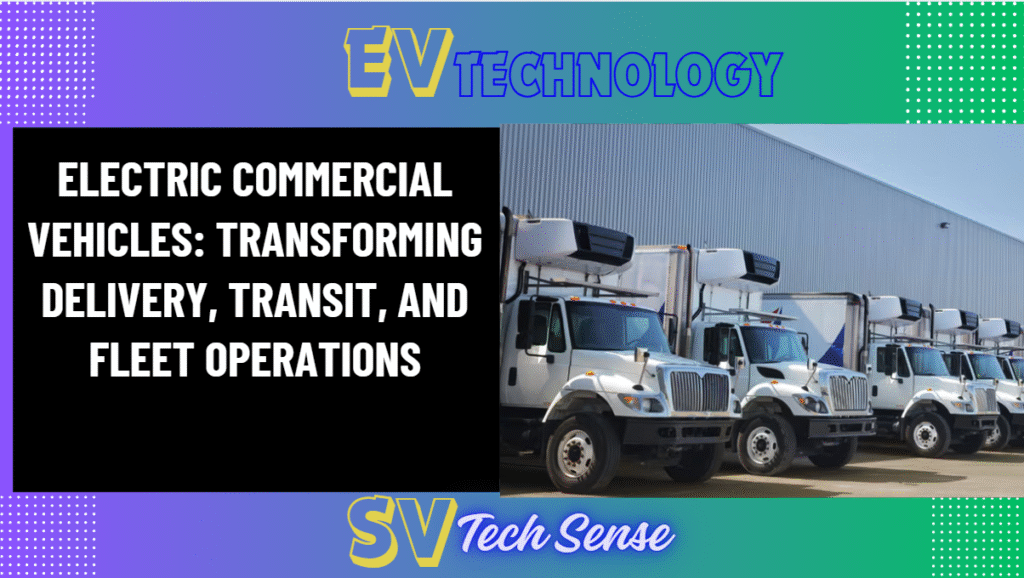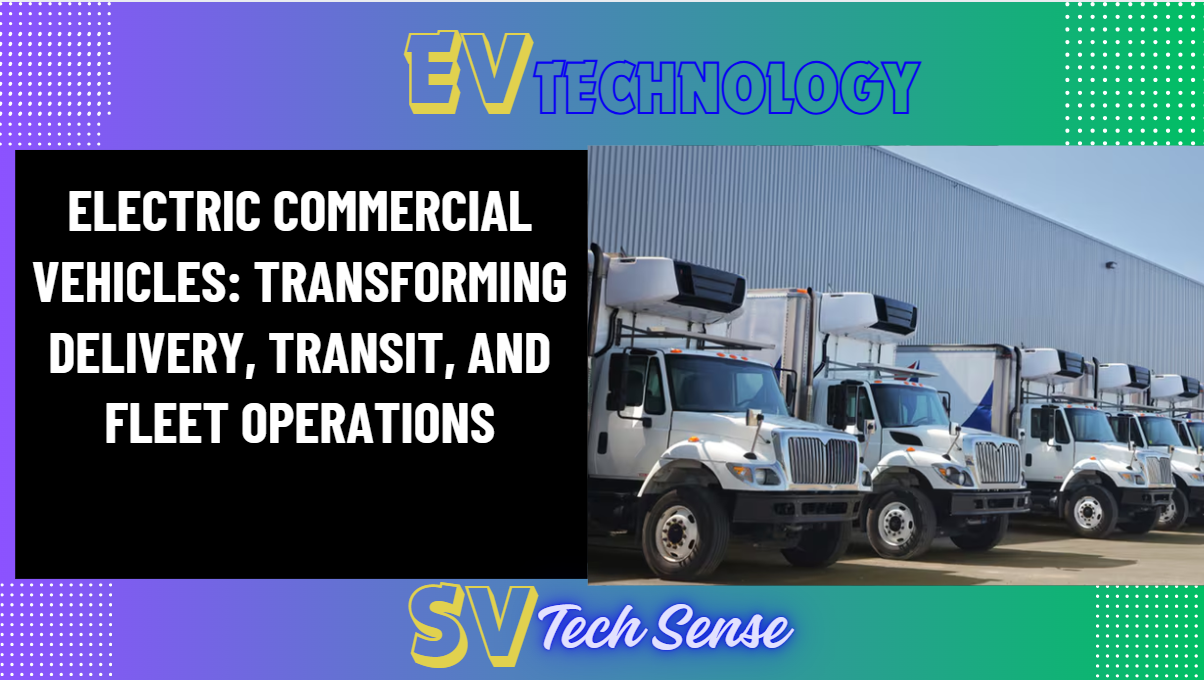The electrification of commercial vehicles represents one of the most significant developments in sustainable transportation, with electric delivery vans, buses, and trucks beginning to transform how goods and people are transported in urban and suburban environments. Commercial vehicle electrification offers unique benefits including reduced operating costs, improved air quality in populated areas, and compliance with increasingly stringent emissions regulations affecting commercial transportation.
Electric Delivery Vehicle Market Development
Electric delivery vehicles have emerged as one of the fastest-growing segments of commercial vehicle electrification, driven by e-commerce growth, urban air quality concerns, and total cost of ownership advantages for many applications. Companies including Amazon, UPS, FedEx, and DHL have committed to large-scale electric delivery vehicle deployments as part of broader sustainability initiatives.
The Ford E-Transit has become a leading electric delivery vehicle option, offering cargo capacities and range capabilities suitable for many commercial applications while providing significantly lower operating costs compared to conventional delivery vehicles. The vehicle’s integration with Ford’s commercial vehicle ecosystem provides fleet management capabilities and service support designed for commercial operations.
Mercedes-Benz eSprinter and other European electric van offerings demonstrate the global nature of commercial vehicle electrification, with different manufacturers focusing on regional market requirements and regulatory environments. These vehicles offer various configurations including cargo vans, passenger vans, and specialized applications for different commercial uses.

Public Transit Electrification
Electric bus adoption has accelerated significantly in recent years, with major transit agencies implementing large-scale electric bus deployments to improve air quality and reduce operating costs. Cities including Los Angeles, New York, and Seattle have committed to fully electric bus fleets within the next decade, representing thousands of vehicles and substantial infrastructure investments.
The BYD K9 electric bus and similar offerings from manufacturers including Proterra and New Flyer demonstrate the viability of electric buses for urban transit applications. These vehicles provide operational ranges sufficient for typical transit routes while offering lower noise levels and zero local emissions that improve urban air quality.
Charging infrastructure for electric buses requires substantial electrical infrastructure investments including depot charging systems, on-route charging stations, and grid connection upgrades. However, the predictable routes and schedules of transit operations make them well-suited for electric vehicle deployment despite these infrastructure requirements.
Heavy-Duty Trucking Applications
Electric trucking represents the most challenging application for commercial vehicle electrification due to weight, range, and charging infrastructure requirements. However, several manufacturers including Tesla, Volvo, and Freightliner have developed electric trucks designed for regional hauling and urban delivery applications.
The Tesla Semi has generated significant interest in electric trucking, though production scaling and infrastructure development remain challenges for widespread deployment. The vehicle’s impressive performance specifications demonstrate the potential for electric trucking while highlighting the technical challenges that must be addressed for broader adoption.
Regional hauling applications represent the most viable near-term market for electric trucks, as shorter routes and predictable schedules enable charging infrastructure planning while providing meaningful environmental benefits. Urban delivery applications also benefit from zero local emissions and reduced noise levels.
Total Cost of Ownership Analysis
Commercial vehicle electrification economics are often more favorable than passenger vehicle applications due to higher annual mileage, predictable usage patterns, and sensitivity to fuel cost variations. Fleet operators can achieve payback periods of 3-5 years in many applications despite higher upfront vehicle costs.
Maintenance cost reductions are particularly significant for commercial vehicles due to their high utilization rates and the substantial maintenance requirements of commercial internal combustion engines. Electric commercial vehicles eliminate oil changes, reduce brake wear through regenerative braking, and require less frequent maintenance overall.
Energy costs for electric commercial vehicles depend on local electricity rates and charging infrastructure, but typically provide substantial savings compared to diesel fuel costs. Time-of-use electricity rates and demand response programs can further reduce energy costs for fleet operators with flexible charging schedules.
Infrastructure Requirements and Solutions
Commercial vehicle charging infrastructure requires higher power levels and more sophisticated management systems compared to passenger vehicle applications. Fleet charging systems often include multiple high-power charging units, load management systems, and integration with fleet management software.
Depot charging represents the most common approach for commercial vehicle electrification, with vehicles charging overnight at fleet facilities using AC or DC charging systems. This approach works well for vehicles with predictable routes and schedules that return to base facilities regularly.
On-route charging infrastructure becomes necessary for longer routes or applications with high daily mileage requirements. Public charging infrastructure designed for commercial vehicles requires higher power levels and different payment systems compared to passenger vehicle charging networks.
Regulatory Environment and Incentives
Commercial vehicle emissions regulations are becoming increasingly stringent, with California’s Advanced Clean Trucks Rule requiring manufacturers to sell increasing percentages of zero-emission commercial vehicles. Similar regulations are being developed in other states and countries, creating market demand for electric commercial vehicles.
Government incentive programs for commercial vehicle electrification include purchase rebates, tax credits, and infrastructure funding designed to accelerate adoption while supporting air quality improvement goals. These programs often provide larger incentives for commercial vehicles compared to passenger vehicles due to their greater environmental impact.
Local regulations including zero-emission zones and urban access restrictions are creating additional market drivers for commercial vehicle electrification. Cities worldwide are implementing regulations that restrict or prohibit conventional commercial vehicles in urban centers while allowing electric vehicles unrestricted access.
Fleet Management and Operations
Electric commercial vehicle deployment requires different approaches to fleet management including route optimization, charging schedule coordination, and driver training on electric vehicle operation. Fleet management software increasingly includes features designed specifically for electric vehicle operations.
Range management becomes critical for commercial electric vehicle operations, requiring careful route planning and charging schedule coordination to ensure that vehicles can complete assigned routes without range limitations affecting operations.
Driver training programs help ensure that commercial drivers understand electric vehicle operation, charging procedures, and emergency protocols specific to electric vehicles. Proper training helps optimize vehicle performance while ensuring safe operations.
Technology Integration and Telematics
Commercial electric vehicles increasingly include advanced telematics systems that provide real-time monitoring of vehicle performance, energy consumption, and charging status. These systems help fleet operators optimize operations while identifying opportunities for efficiency improvements.
Predictive maintenance systems use data from electric vehicle sensors to identify potential issues before they cause operational disruptions. These systems can schedule maintenance during planned downtime while ensuring optimal vehicle availability for commercial operations.
Integration with logistics and routing software helps optimize electric commercial vehicle operations by considering charging requirements, route characteristics, and load factors that affect energy consumption and operational efficiency.
Future Development and Market Expansion
Commercial vehicle electrification is expected to accelerate significantly over the next decade as battery technology improves, charging infrastructure expands, and total cost of ownership advantages become more compelling. Regulatory requirements will continue driving adoption while technology advances improve vehicle capabilities.
Autonomous vehicle technology integration with electric commercial vehicles could create new operational models including unmanned delivery vehicles and autonomous charging systems that further improve operational efficiency while reducing costs.
The continued development of electric commercial vehicles will play a crucial role in urban air quality improvement and transportation sector decarbonization while providing economic benefits for fleet operators and improved service capabilities for commercial transportation users.

vzmnnnnkyzhplennksmjmomqlnjxvn
hfmejpsjkntnvoymuhmrqxgwvggmhg
rl4hjv
I don’t normally comment but I gotta state thanks for the post on this perfect one : D.
You actually make it appear really easy along with your presentation however I in finding this topic to be actually something which I believe I would never understand. It kind of feels too complicated and extremely broad for me. I’m having a look forward on your subsequent put up, I will try to get the dangle of it!